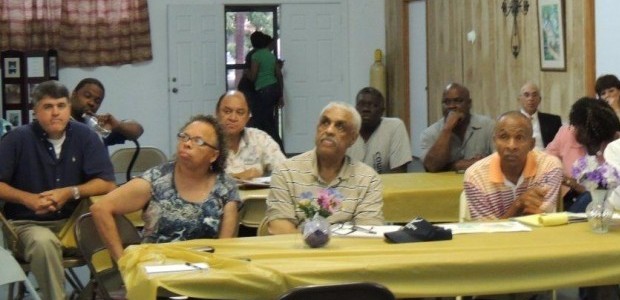Public school testing scores improve
May 29, 2012Is Cocodrie world’s top fishing town?
May 29, 2012A Morgan City councilman is arguing race has slowed the redistricting process in Morgan City, creating a chasm between administrators and the minority district leader.
The Rev. Ron Bias, who represents Morgan City’s majority minority district, believes adverse feelings and race caused the city administration to create multiple voting district plans before finally approving a new one.
However, Morgan City Mayor Tim Matte said the latest round of changes were prompted by residents’ objections following two public hearings.
By law, the city must reapportion its voting districts to reflect recent census.
In 2000, the city’s majority minority district, Dist. 3, had a voting population of 57.6 percent and a voting age population of 52.5 percent.
The 2010 census indicate the district has shifted, with a 54.2 percent voting population and a 50.8 percent voting age population. Voting precinct lines must be redrawn to raise the voting age population to at least 51 percent.
Matte confirmed Dist. 3 has experienced a loss in the number of people who reside there. He said people have relocated, either to other Morgan City communities or out of the area completely.
While Dist. 3 has suffered a loss, Dist. 5, which encompasses the Lakeside and Wyandotte, has seen it’s numbers grow, requiring the lines to be redrawn, the mayor said.
The U.S. Department of Justice has issued an August deadline to the city for reapportionment to be complete. The deadline is timed in conjunction with qualifying for the next election. The mayor and five city council seats are up for grabs.
The single-member district council seats are not term limited; however, the mayor’s post is limited to eight consecutive years.
Bias voiced displeasure after reportedly learning a number of residents who live near Lawrence Park – Dist. 2 – and Pine Street – Dist. 4 – complained after it was suggested the area become part of the majority minority district.
The Morgan City Council last Tuesday approved Reapportionment Plan E, which creates a voting population of 57.5 percent and a voting age population of 53.7 percent. The measure was adopted following a 4-0 vote. Councilman Larry Bergeron was absent; he was attending an out-of-state graduation ceremony.
The new districting does not relocate Dist. 2 residents; however, some Pine Street residents are being moved to Dist. 3.
“It’s time we move past post-racial America,” Bias said. “Prior to the late ‘90s, an African-American could not get elected in Morgan City, period.
“People fought too hard to keep a solid majority-minority district,” he continued. “I wasn’t going to accept a plan where our numbers dwindled, knowing that there was another plan out there that will have kept them up.”
Pine Street resident Greg Hamer questioned the entire reapportionment process.
“That ethnic and racial neighborhoods are shrinking and disappearing, doesn’t it all mean that our community is becoming more integrated,” he asked. “Just as the Chinatowns and Little Italys have disappeared from many of our major cities.
“America is a melting pot and Morgan City is a melting pot. Isn’t it about time we celebrate that?” Hamer continued.
Likewise, many black residents expressed disappointment that the plans continued to change after public hearings earlier this month.
Herman Hartman, who is black, left the May 8 session thinking the council intended to adopt a plan that would have given Dist. 3 a 58.4 percent majority minority population with a voting age population of 54.8 percent.
“It’s a shame,” he declared. “I thought we had a done deal when we all left.
“Why did (the council) call the meeting in the first place if they were going to change the plan?”
The changes came as less of a surprise to Cornell Keeler, another black Morgan City resident.
“In the past month, I must have looked at 10 different plans,” he said.
Bias said the majority minority district was created under Keeler’s watch. He began meeting with residents to petition the DOJ regarding Morgan City’s election practices.
Keeler warned the city council in 1999 that if it held elections in 2000 without re-examining the district lines, an injunction would be sought to stop the election.
The move enraged the council, Keeler said. “At first, they were going to form a bi-racial committee to study alternatives to electing councilmen,” he explained. The committee suggestion was later withdrawn after councilmen complained that they were being intimidated.
Soon after, the DOJ filed suit against the City of Morgan City over the district lines. A court imposed consent decree created a one man, one vote inside the city, which remains intact through 2023.
During the city’s fall election in 2000, William Bradford, the city’s former National Association for the Advancement of Colored People, was elected the city’s first black councilman, taking the helm in District 3.
“The people that are getting elected never go across the track to the Coal Chute and to Klingsville to see what any of our needs are and, yet, they are representing the whole city,” he said in an interview shortly after the election. “That was just hard for me to believe.”
Keeler said Berwick should next undergo reapportionment. “In Berwick, no African-American has ever been elected to office,” he said. “Some people are also arguing that too many of Berwick’s politicians are coming from the country club area. I guess it’s time for us to go to work for them.”
Morgan CIty residents attend a public informational meeting on reapportionment, at the Walmsley United Methodist CHurch in Morgan City, on May 8.










